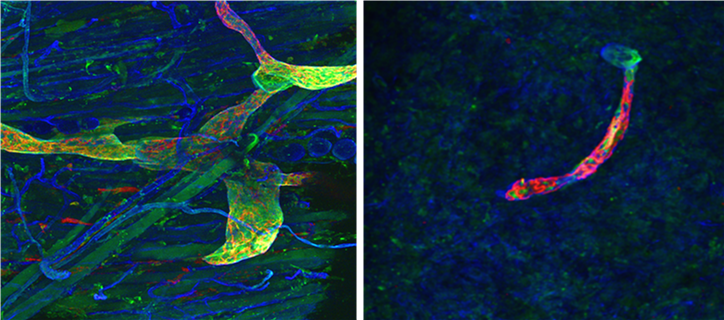Adriana Larregina, M.D., Ph.D.

Contact
Campus: Thomas E. Starzl Biomedical Science Tower, 200 Lothrop St
Office: W1147 BST
Lab: W1113 BST
Pittsburgh, PA 15261
Ph: 412-383-9842
Fax: 412-648-8117
Education
- M.D. National University of La Plata, Buenos Aires, Argentina
- Pathologist. University of Buenos Aires, Argentina
- Ph.D. University of Buenos Aires, Argentina
- Post-Doctoral Associate. Victoria University of Manchester. United Kingdom
Academic Affiliation
- Professor, Department of Dermatology
- Professor, Department of Immunology
- Faculty of “The McGowan Institute for Regenerative Medicine”
- Member of the University of Pittsburgh Cancer Institute
About Research
Relevant Finds from our lab
For more than two decades, the focus of my research has been to understand how the skin immune system works. We are interested in modifying the skin microenvironment for the development of immune-stimulatory or -suppressive vaccines. We focus in how skin secreted neuropeptides modify the function ofdendritic cells (DCs), mast cells (MCs) and T cells as initiators and effectors of cutaneous innate and adaptive immune responses
In search for efficient ways to improve or suppress DC and MC functions we developed a particular interest in the study of substance-P (SP) and hemokinin-1 (HK-1) two of the most potent pro-inflammatory neuropeptides secreted in the skin.
We demonstrated that DCs express the neurokinin-1 receptor (NK1R) which is the high affinity receptor for SP and HK-1. Agonistic signaling of the receptor in the context of skin genetic immunizations promotes DC survival during Ag presentation resulting in potent cellular immune responses.
We further described the cellular and molecular mechanisms following NK1R signaling in the activation and bias of naïve T cells in skin draining lymph nodes (sDLNs). Using NK1R agonists, we demonstrated that skin migratory DCs downregulate IL-10 to potentiate the T cell-stimulatory and type 1 functions of other DC residents or recruited to the sDLN.
To understand other inflammatory mechanisms employed by NK1R agonists to modulate innate immune responses and bias of Th2 lymphocytes, we are investigating the role of signaling the receptor in the outcome of inflammatory responses mediated by IgE activated mast cells (MCs).
We described that MCs synthesize and secrete HK-1 and NK1R-signaling by autocrine HK-1 potentiates the inflammatory functions of IgE activated MCs. Mechanistic studies demonstrated that HK-1 increases the expression of the high affinity IgE receptor, triggers MC degranulation, and augments the synthesis of TNF-α and IL-6, cytokines necessary for development of Th2 responses underlying allergic diseases.
Together these relevant data demonstrated for the first time that NK1R-signaling in vivo provides adjuvant effect to type 1 cellular immunity as well as to Th2 humoral immunity that sustains skin chronic inflammatory and atopic diseases.

Skin whole mount showing normal lymphatic and blood vessels in WT mice (left) and pathologic ones in neurokinin 1 receptor KO mice (left)
Our new Projects
Currently we are investigating the molecular mechanisms involved in the direct stimulation T cells by SP and HK-1 and in the role of blocking the NK1R for immune-suppressive immunizations to treat contact and atopic dermatitis. To this purpose, we use Ag and NK1R antagonists incorporated in self-dissolving microneedles arrays a technology that allows simultaneous, efficient and consistent delivery of biologics to specific skin strata.
Funding
NIH/NIAMS: R01 AR068249.
Title: Manipulating Cutaneous Neuroimmunity to Treat Contact Dermatitis
Role: PI.
Years:7/1/2015-6/30/2020
NIH/NIAMS: 1R01 AR071277
Title: MNA Delivery of Neurokinin 1 Receptor Antagonists to Treat Atopic Dermatitis
Role: PI
7/1/2015 -6/30/2020
NIH/ NIHLBI: R01HL130191.
Title: Exosomes as paracrine signal mediators in cardiac allograft rejection.
Role: CoI. PI Adriana Morelli
Years: 02/1/2016 – 1/31/2020
NIH/NIAMS: K01 AR067250 Manipulating Neuropeptide Receptors in Mast Cells for Atopic Dermatitis Treatment
Role: Scientific Mentor. PI Tina Sumpter
Patent
Title: Skin microenvironment targeted delivery for promoting immune and other responses. Falo LD Jr. Larregina AT. Co-Inventors.Ref. No. 8123-95880-03 Application No. 16/067,812, filed July 2, 2018. Country: USA
Selected Publications
Research Interests
- Skin Immunology
- Role of neuroinflammation in the outcome of the skin immune function
- Manipulation of neuroinflammation to treat chronic inflammatory skin disorders
